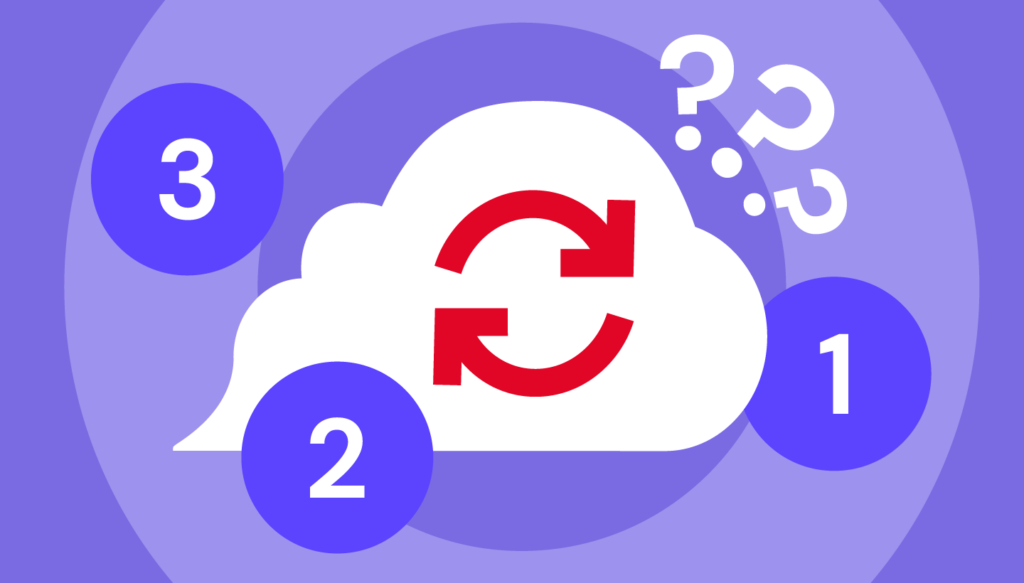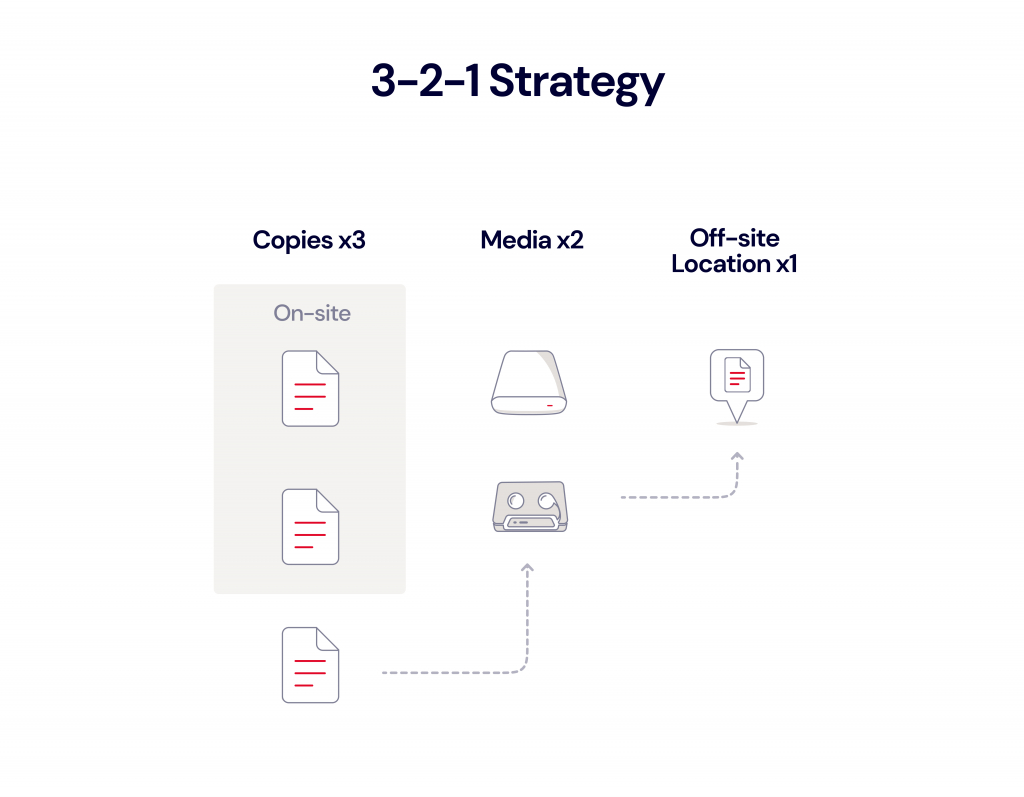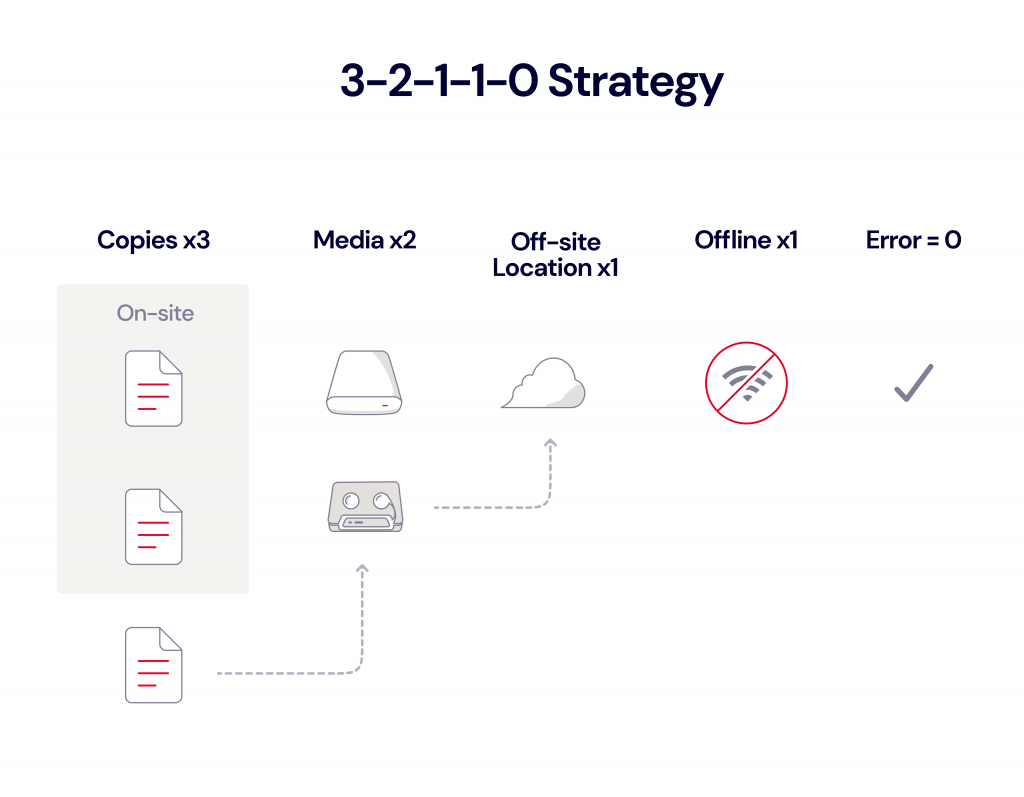
Are you confident that your backup strategy has you covered? If not, it’s time to confront the reality that your backup strategy might not be as strong as you think. And even if you’re feeling great about it, it can never hurt to poke holes in your strategy to see where you need to shore up your defenses.
Whether you’re a small business owner wearing many hats (including the responsibility for backing up your company’s data) or a seasoned IT professional, you know that protecting your data is a top priority. The industry standard is the 3-2-1 backup strategy, which states you should have three copies of your data on two different kinds of media with at least one copy off-site or in the cloud. But a lot has changed since that standard was introduced.
In this post, we’ll identify several ways your 3-2-1 strategy (and your backups in general) could fail. These are common mistakes that even professional IT teams can make. While 3-2-1 is a great place to start, especially if you’re not currently following that approach, it can now be considered table stakes.
For larger businesses or any business wanting to fail proof its backups, read on to learn how you can plug the gaps in your 3-2-1 strategy and better secure your data from ransomware and other disasters.
Let’s start with a quick review of the 3-2-1 strategy.
The 3-2-1 Backup Strategy
A 3-2-1 strategy means having at least three total copies of your data, two of which are local but on different media, and at least one off-site copy or in the cloud. For instance, a business may keep a local copy of its data on a server at the main office, a second copy of its data on a NAS device in the same location, and a third copy of its data in the public cloud, such as Backblaze B2 Cloud Storage. Hence, there are three copies of its data with two local copies on different media (the server and NAS) and one copy stored off-site in the cloud.

The 3-2-1 rule originated in 2005 when Peter Krogh, a photographer, writer, and consultant, introduced it in his book, “The DAM Book: Digital Asset Management for Photographers.” As this rule was developed almost 20 years ago, you can imagine that it may be outdated in some regards. Consider that 2005 was the year YouTube was founded. Let’s face it, a lot has changed since 2005, and today the 3-2-1 strategy is just the starting point. In fact, even if you’re faithfully following the 3-2-1 rule, there may still be some gaps in your data protection strategy.
While backups to external hard drives, tape, and other recordable media (CDs, DVDs, and SD cards) were common two decades ago, those modalities are now considered legacy storage. The public cloud was a relatively new innovation in 2005, so, at first, 3-2-1 did not even consider the possibilities of cloud storage.
Arguably, the entire concept of “media” in 3-2-1 (as in having two local copies of your data on two different kinds of media) may not make sense in today’s modern IT environment. And, while an on-premises copy of your data typically offers the fastest Recovery Time Objective (RTO), having two local copies of your data will not protect against the multitude of potential natural disasters like fire, floods, tornados, and earthquakes.
The “2” part of the 3-2-1 equation may make sense for consumers and sole proprietors (e.g., photographers, graphic designers, etc.) who are prone to hardware failure and for whom having a second copy of data on a NAS device or external hard drive is an easy solution, but enterprises have more complex infrastructures.
Enterprises may be better served by having more than one off-site copy, in case of an on-premises data disaster. This can be easily automated with a cloud replication tool which allows you to store your data in different regions. (Backblaze offers Cloud Replication for this purpose.) Replicating your data across regions provides geographical separation from your production environment and added redundancy. The bottom line is that 3-2-1 is a good starting point for configuring your backup strategy, but it should not be taken as a one-size-fits-all approach.
The 3-2-1-1-0 Strategy
Some companies in the data protection space, like Veeam, have updated 3-2-1 with the 3-2-1-1-0 approach. This particular definition stipulates that you:
- Maintain at least three copies of business data.
- Store data on at least two different types of storage media.
- Keep one copy of the backups in an off-site location.
- Keep one copy of the media offline or air gapped.
- Ensure all recoverability solutions have zero errors.

The 3-2-1-1-0 approach addresses two important weaknesses of 3-2-1. First, 3-2-1 doesn’t address the prevalence of ransomware. Even if you follow 3-2-1 with fidelity, your data could still be vulnerable to a ransomware attack. The 3-2-1-1-0 rule covers this by requiring one copy to be offline or air gapped. With Object Lock, your data can be made immutable, which is considered a virtual air gap, thus fulfilling the 3-2-1-1-0 rule.
Second, 3-2-1 does not consider disaster recovery (DR) needs. While backups are one part of your disaster recovery plan, your DR plan needs to consider many more factors. The “0” in 3-2-1-1-0 captures an important aspect of DR planning, which is that you must test your backups and ensure you can recover from them without error. Ultimately, you should architect your backup strategy to support your DR plan and the potential need for a recovery, rather than trying to abide by any particular backup rule.
Additional Gaps in Your Backup Strategy
As you can tell by now, there are many shades of gray when it comes to 3-2-1, and these varying interpretations can create areas of weakness in a business’ data protection plan. Review your own plan for the following seven common mistakes and close the gaps in your strategy by implementing the suggested best practices.
1. Using Sync Functionality Instead of Backing Up
You may be following 3-2-1, but if copies of your data are stored on a sync service like Google Drive, Dropbox, or OneDrive, you’re not fully protected. Syncing your data does not allow you to recover from previous versions with the level of granularity that a backup offers.
Best Practice: Instead, ensure you have three copies of your data protected by true backup functionality.
2. Counting Production Data as a Backup
Some interpret the production data to be one of the three copies of data or one of the two different media types.
Best Practice: It’s open to interpretation, but you may want to consider having three copies of data in addition to your production data for the best protection.
3. Using a Storage Appliance That’s Vulnerable to Ransomware
Many on-premises storage systems now support immutability, so it’s a good time to reevaluate your local storage.
Best Practice: New features in popular backup software like Veeam even enable NAS devices to be protected from ransomware. Learn more about Veeam support for NAS immutability and how to orchestrate end-to-end immutability for impenetrable backups.
4. Not Backing Up Your SaaS Data
It’s a mistake to think your Microsoft 365, Google Workspace, and other software as a service (SaaS) data is protected because it’s already hosted in the cloud. SaaS providers operate under a “shared responsibility model,” meaning they may not back up your data as often as you’d like or provide effective means to recovery.
Best Practice: Be sure to back up your SaaS data to the cloud to ensure complete coverage of the 3-2-1 rule.
5. Relying On Off-Site Legacy Storage
It’s always a good idea to have at least one copy of your data on-site for the fastest RTO. But if you’re relying on legacy storage, like tape, to fulfill the off-site requirement of the 3-2-1 strategy, you probably know how expensive and time-consuming it can be. And sometimes that expense and timesuck means your off-site backups are not updated as often as they should be, which leads to mistakes.
Best Practice: Replace your off-site storage with cloud storage to modernize your architecture and prevent gaps in your backups. Backblaze B2 is one-fifth of the cost of AWS, so it’s easily affordable to migrate off tape and other legacy storage systems.
6. No Plan for Affected Infrastructure
Faithfully following 3-2-1 will get you nowhere if you don’t have the infrastructure to restore your backups. If your infrastructure is destroyed or disrupted, you need a way to ensure business continuity in the face of data disaster.
Best Practice: Be sure your disaster recovery plan outlines how you will access your DR documentation and implement the plan even if your environment is down. Using a tool like Cloud Instant Business Recovery (Cloud IBR), which offers an on-demand, automated solution that allows Veeam users to stand up bare metal servers in the cloud, allows you to immediately begin recovering data while rebuilding infrastructure.
7. Keeping Your Off-Site Copy Down the Street
The 3-2-1 policy states that one copy of your data be kept off-site, and some companies maintain a DR site for that exact purpose. However, if your DR facility is in the same local area as your main office, you have a big gap in your data protection strategy.
Best Practice: Ideally, you should have an off-site copy of your data stored in a public cloud data center far from your data production site, to protect against regional natural disasters.
Telco Adopts Cloud for Geographic Separation
AcenTek’s existing storage scheme covered the 3-2-1 basics, but their off-site copy was no further away than their own data center. In the case of a large natural disaster, their one off-site copy could be vulnerable to destruction, leaving them without a path to recovery. With Backblaze B2, AcenTek has an additional layer of resilience for its backup data by storing it in a secure, immutable cloud storage platform across the country from their headquarters in Minnesota.

Modernize Your Backup Strategy
The 3-2-1 strategy is a great starting point for small businesses that need to develop a backup plan, but larger mid-market and enterprise organizations must think about business continuity more holistically.
Backblaze B2 Cloud Storage makes it easy to modernize your backup strategy by sending data backups and archives straight to the cloud—without the expense and complexity of many public cloud services.
At one-fifth of the price of AWS, Backblaze B2 is an affordable, time-saving alternative to the hyperscalers, LTO, and traditional DR sites. Get started today or contact Sales for more information on Backblaze B2 Reserve, Backblaze’s all-inclusive capacity-based pricing that includes premium support and no egress fees. The intricacies of operations, data management, and potential risks demand a more advanced approach to ensure uninterrupted operations. By leveraging cloud storage, you can create a robust, cost-effective, and flexible backup strategy that you can easily customize to your business needs.
Interested in learning more about backup, business continuity, and disaster recovery best practices? Check out the free Backblaze resources below.




